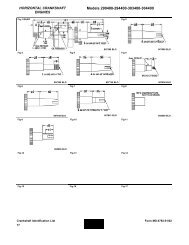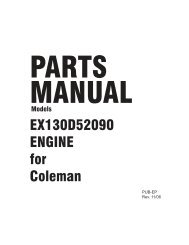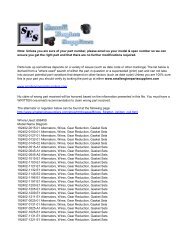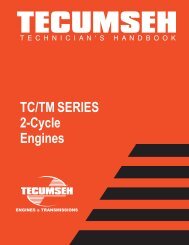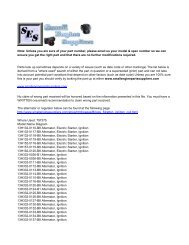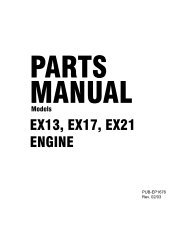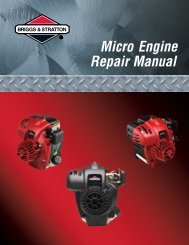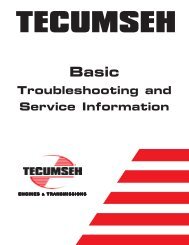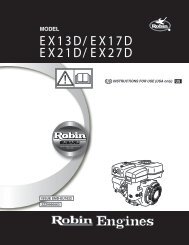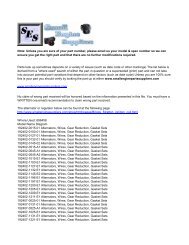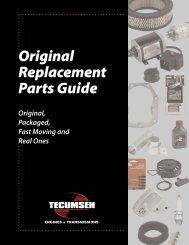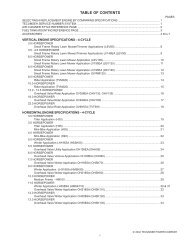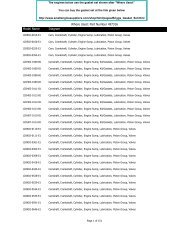3to 11hp 4-cycle l-head engines - Small Engine Suppliers
3to 11hp 4-cycle l-head engines - Small Engine Suppliers
3to 11hp 4-cycle l-head engines - Small Engine Suppliers
You also want an ePaper? Increase the reach of your titles
YUMPU automatically turns print PDFs into web optimized ePapers that Google loves.
5. Check the engine valve lash. Reset the valves at the proper lash.<br />
6. Check the valves for proper seating and valve guide lash. Recondition the valves and seats. Replace the valves<br />
if necessary.<br />
7. Check the ignition timing. Check the flywheel key for partial shearing.<br />
SERVICE<br />
DISASSEMBLY PROCEDURE<br />
COVER BEZEL<br />
PRESS IN AND LIFT<br />
HERE TO RELEASE<br />
COVER<br />
The following procedures apply to most engine models.<br />
Actual procedure may vary.<br />
1. Disconnect the high tension lead from the spark plug.<br />
Remove the spark plug.<br />
2. Drain the oil from the crankcase. Drain or shut off the<br />
fuel supply.<br />
3. Remove the air cleaner assembly.<br />
4. Remove the fuel tank if it is attached to the engine.<br />
Fuel tanks may be held on with bolts, screws, or some<br />
models require taps upward with a soft face hammer<br />
loosening the plastic tank wedged in the blower<br />
housing slots.<br />
On some LEV engine models, removal of the bezel<br />
cover is necessary to view the engine identification<br />
or to provide access to the recoil assembly screws.<br />
Push in toward the spark plug end (as shown), lift up<br />
to clear the recoil, then pull the cover away from the<br />
spark plug to remove. (diag. 11)<br />
5. Remove the blower housing by first unscrewing the<br />
screw holding the dipstick tube to the blower housing<br />
or unscrewing the dipstick tube and removing the<br />
remaining bolts on the blower housing.<br />
6. Unplug the ignition kill wire from the terminal on top<br />
of the ignition module and unbolt the ignition module.<br />
7. Remove the flywheel nut, washer, and starter cup.<br />
Use a strap wrench (part # 670305) to hold the<br />
flywheel from turning (diag. 12). Thread the<br />
appropriate flywheel knock-off tool part # 670103,<br />
(7/16") or part # 670169 (1/2") on the crankshaft until<br />
it bottoms out, then back-off one complete turn. Using<br />
a large screwdriver, lift upward under the flywheel<br />
and tap sharply and squarely on the knock-off tool to<br />
break the flywheel loose. If necessary, rotate the<br />
flywheel a half turn and repeat until it loosens (diag.<br />
13). A flywheel puller (part # 670306) may be used<br />
on <strong>engines</strong> with cored holes and also on flywheels<br />
with holes drilled and tapped (diag. 14).<br />
NOTE: DO NOT USE A JAW TYPE PULLER.<br />
8. Remove the flywheel key, stator, and baffle plate.<br />
9. Remove the muffler.<br />
10. Remove the intake pipe and the carburetor. Be careful<br />
not to bend or damage the linkage when removing.<br />
Mark the hookup points or diagram the linkage<br />
arrangement to aid in reassembly.<br />
11. Remove the cylinder <strong>head</strong>.<br />
12. Remove the crankcase breather.<br />
MODEL AND<br />
D.O.M. NUMBER<br />
DECAL<br />
LOCATED<br />
UNDER COVER<br />
(IF SO EQUIPPED)<br />
FLYWHEEL<br />
TOOL<br />
METAL HAMMER<br />
(continued on top of next page)<br />
SOCKET WRENCH<br />
FLYWHEEL<br />
KNOCK OFF TOOL<br />
11<br />
12<br />
SCREWDRIVER TO<br />
RAISE FLYWHEEL<br />
13<br />
14<br />
79



